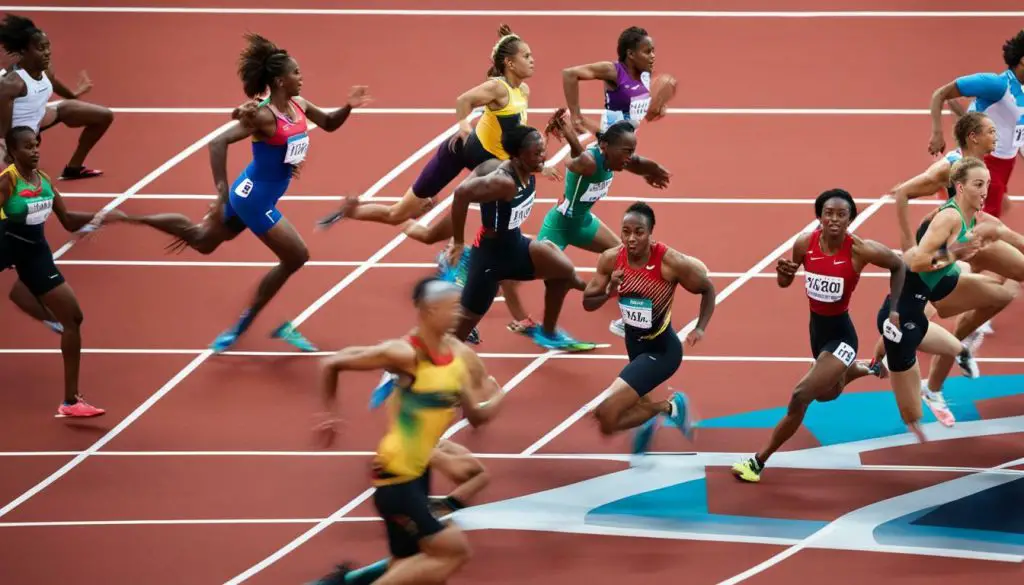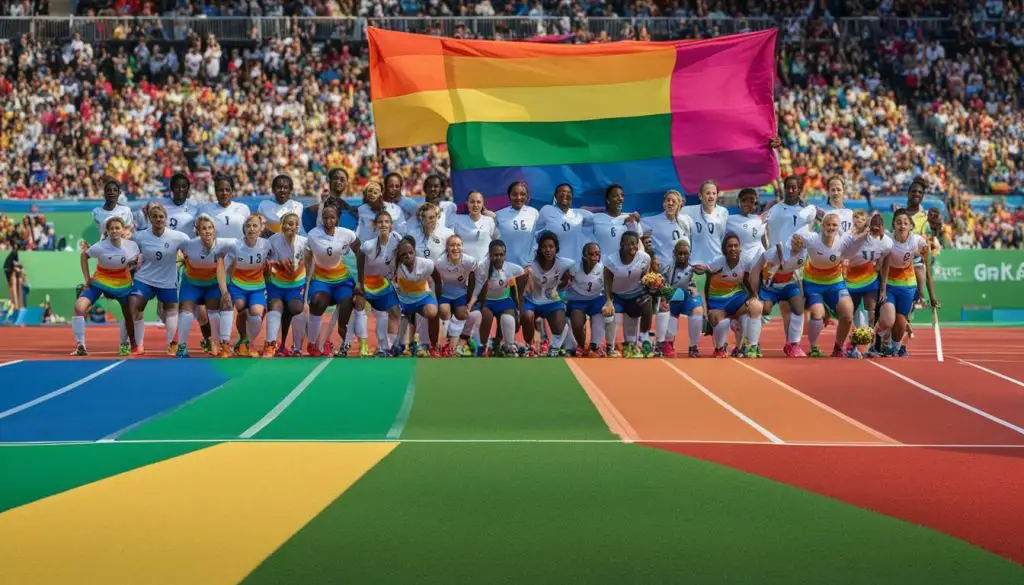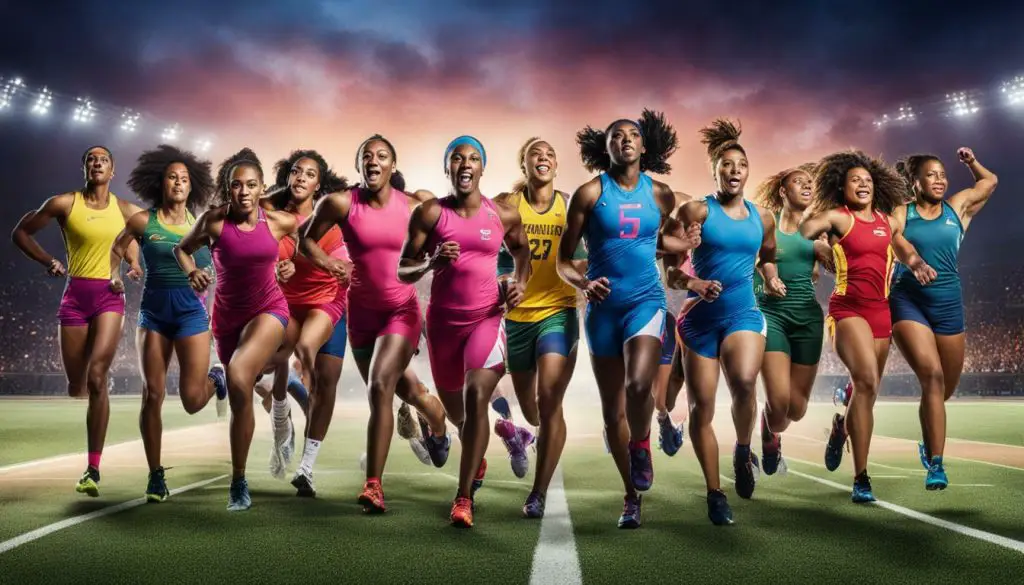The participation of transgender athletes in the Olympics has been a subject of debate and controversy in recent years. With the aim of promoting inclusivity and respecting human rights, the International Olympic Committee (IOC) has announced new guidelines for transgender and intersex athletes. These guidelines no longer require athletes to undergo hormone level modifications to be eligible to compete, a significant departure from previous requirements.
While this change has been welcomed by advocates for transgender inclusivity in sports, it has also sparked discussions about the potential impact on state bills in the United States that restrict transgender students’ participation in school sports. The IOC’s emphasis on gender diversity and the removal of unnecessary procedures aligns with the growing recognition of gender identity in the sporting world.
However, not all governing bodies share the same stance. World Athletics, the governing body for international track and field, has chosen to bar transgender women athletes from competing in elite women’s competitions. This decision is based on concerns about fairness and the integrity of female competition. Limited scientific research on transgender athletes in elite sports suggests that they may have physical advantages over cisgender women, even after undergoing hormone therapy.
One of the key points of contention is the appropriate testosterone levels for transgender women athletes to be eligible to compete. Currently, the IOC requires a testosterone level of 10 nanomoles per liter for at least 12 months prior to competing, while World Athletics sets the threshold at below 5 nanomoles per liter continuously for at least 12 months. The ongoing debate surrounding these levels reflects the complexity of addressing inclusion and fairness in the realm of competitive sports.
It is important to note that the current guidelines lack specific regulations for transgender men in elite sports. This further highlights the need for continued discussions and research on the inclusion of transgender athletes in various sporting contexts.
In conclusion, the question of whether transgender athletes can compete in the Olympics remains a complex and evolving topic. While the IOC’s new guidelines promote inclusivity and respect for human rights, differing stances from governing bodies like World Athletics reflect concerns about fairness and competition integrity. The ongoing debate on hormone levels and eligibility criteria underscores the need for further scientific research and thoughtful analysis to ensure a balanced and inclusive approach to transgender participation in Olympic sports.
The International Olympic Committee (IOC) Guidelines for Transgender Athletes
The International Olympic Committee (IOC) has recently released new guidelines that address the participation of transgender and intersex athletes in Olympic competitions. These guidelines aim to create a more inclusive and respectful environment for athletes of all gender identities while ensuring fairness and the integrity of competition.
One of the significant changes is that the IOC will no longer require transgender athletes to undergo hormone level modifications to compete. Instead, competitions should follow principles grounded in respect for human rights. This framework replaces the previous guidelines from 2015, which many advocates considered to be unnecessarily invasive and burdensome.

Impact on Transgender Students’ Participation in School Sports
The new guidelines may have implications for state bills in the US that restrict transgender students’ participation in school sports. By eliminating the requirement for hormone level modifications, the IOC’s stance supports the inclusion of transgender athletes in sports activities at all levels, promoting equality and acceptance.
However, it is important to note that World Athletics, the governing body for international track and field, has adopted a different approach. They have decided to bar transgender women athletes from elite competitions for women, citing concerns about fairness and the integrity of female competition. This decision has sparked ongoing debate about the eligibility of transgender women and the appropriate testosterone levels required for them to compete.
While limited scientific research exists on the subject, it suggests that transgender women may have a physical advantage over cisgender women, even after undergoing hormone therapy. The IOC currently requires transgender women to maintain a testosterone level of 10 nanomoles per liter for at least 12 months prior to competing, while World Athletics sets the bar at levels below 5 nanomoles per liter continuously for at least 12 months.
Conclusion
The new guidelines set by the International Olympic Committee (IOC) represent a significant step towards inclusivity in sports and respect for the rights of transgender and intersex athletes. By eliminating the requirement for hormone level modifications, the IOC seeks to create a more accepting environment while still upholding fairness and the integrity of competition. However, differing policies and debates surrounding transgender athletes’ eligibility continue to shape the landscape of sports at both the Olympic and school levels.
World Athletics’ Stance on Transgender Women Athletes
While the International Olympic Committee (IOC) has taken steps towards inclusivity by revising guidelines for transgender and intersex athletes, World Athletics, the governing body for international track and field, has implemented stricter regulations on transgender women athletes’ eligibility to compete in elite competitions. Citing fairness and the integrity of female competition as priorities, World Athletics has decided to bar transgender women athletes from participating.
Scientific research on transgender athletes in elite sports is limited, but it does suggest that transgender women may have a physical advantage over cisgender women, even after undergoing hormone therapy. This advantage, particularly in terms of strength, has raised concerns about creating a level playing field for all athletes. Consequently, World Athletics has set specific testosterone level requirements that transgender women must meet to be eligible to compete.
Currently, the IOC’s guidelines state that transgender women must maintain a testosterone level of 10 nanomoles per liter for at least 12 months prior to competing. In contrast, World Athletics requires levels to be below 5 nanomoles per liter continuously for at least 12 months. These regulations aim to address the potential physical advantages that transgender women athletes may possess.
Furthermore, it is worth noting that there are no specific guidelines in place regarding the eligibility of transgender men in elite sports. The focus has primarily been on transgender women, and the debate continues regarding the appropriate criteria and time frame for transgender men to compete in their respective categories.
| Organization | Transgender Women Athletes | Transgender Men Athletes |
|---|---|---|
| IOC | Testosterone level of 10 nanomoles per liter for at least 12 months prior to competing | No specific guidelines |
| World Athletics | Testosterone level below 5 nanomoles per liter continuously for at least 12 months | No specific guidelines |
“While the IOC has taken steps towards inclusivity, World Athletics has implemented stricter regulations on transgender women athletes’ eligibility to compete in elite competitions.” – Sports Official

The eligibility of transgender athletes, particularly in relation to hormone levels, continues to be a contentious issue in the sports community. The International Olympic Committee (IOC) and World Athletics have differing guidelines regarding hormone therapy and testosterone levels for transgender women. The IOC’s current guidelines require athletes to have a testosterone level of 10 nanomoles per liter for at least 12 months prior to competing, while World Athletics demands levels to be below 5 nanomoles per liter continuously for at least 12 months.
While the IOC’s guidelines have been praised by advocates for removing the requirement of unnecessary procedures, concerns remain about the fairness of allowing transgender women to compete against cisgender women. Limited scientific research on transgender athletes in elite sports suggests that they may have a physical advantage over cisgender women, even after hormone therapy.

The controversy surrounding hormone levels and eligibility also extends to the lack of specific guidelines for transgender men in elite sports. The focus has primarily been on transgender women, leaving the inclusion of transgender men in competitive sports largely unaddressed. This further underscores the need for comprehensive and inclusive policies that consider the diverse experiences and identities of transgender athletes.
Table 1:
| Organization | Testosterone Level Requirement | Time Frame |
|---|---|---|
| International Olympic Committee (IOC) | 10 nanomoles per liter | At least 12 months prior to competing |
| World Athletics | Below 5 nanomoles per liter | Continuously for at least 12 months |
The ongoing debate surrounding hormone levels and eligibility highlights the complexities of ensuring fair and inclusive competition for transgender athletes. While efforts are being made to strike a balance between inclusivity and maintaining the integrity of sports, further research and collaboration are needed to develop comprehensive guidelines that address the concerns and needs of all athletes.
Perspectives on Inclusivity and Fairness
The inclusion of transgender athletes in Olympic sports raises important questions about inclusivity, fairness, and the integrity of competition. Advocates for inclusivity argue that transgender athletes should have the same rights and opportunities as cisgender athletes, and that excluding them based on gender identity goes against the principles of equality and non-discrimination. They believe that everyone should be able to participate in sports, regardless of their gender identity.
On the other hand, concerns about fairness and the integrity of competition have been raised. Some argue that transgender women, who were assigned male at birth and undergo hormone therapy, may have physical advantages over cisgender women due to factors such as bone density and muscle mass. Limited scientific research supports this claim, leading to debates about the appropriate testosterone levels and time frame required for transgender women to compete in women’s sports.
It is essential to find a balance between inclusivity and fairness in sports. While there is a desire to create a level playing field for all athletes, it is also crucial to ensure that transgender athletes are not subjected to unnecessary restrictions or barriers that go against their rights. Finding a solution that considers both inclusivity and fairness will require ongoing discussions, scientific research, and collaboration between sports organizations, medical professionals, and athlete representatives.

The introduction of transgender inclusive sports policies may have far-reaching effects, potentially challenging existing state bills that limit transgender students’ participation in school sports. The recent announcement by the International Olympic Committee (IOC) regarding guidelines for transgender and intersex athletes marks a significant shift in the approach towards inclusivity in sports. Under these new guidelines, athletes will no longer be required to undergo hormone level modifications to compete, allowing transgender athletes to participate based on their gender identity without discrimination.
While this represents a positive step towards greater inclusivity, it has also generated controversy. World Athletics, the governing body for international track and field, has chosen to take a different stance by barring transgender women athletes from elite competitions for women. Their decision is grounded in concerns about fairness and the integrity of female competition, highlighting the ongoing debate surrounding the physical advantages that transgender women may have over cisgender women in terms of strength, even after hormone therapy.
Scientific research on the topic is limited, and determining appropriate guidelines for transgender athletes’ eligibility remains a challenge. Currently, the IOC requires transgender women to maintain a testosterone level below 10 nanomoles per liter for at least 12 months prior to competing, while World Athletics stipulates levels below 5 nanomoles per liter continuously for at least 12 months. However, there are no specific guidelines addressing the eligibility of transgender men in elite sports.

| Governing Body | Transgender Women | Transgender Men |
|---|---|---|
| International Olympic Committee (IOC) | Testosterone levels below 10 nanomoles per liter for 12 months | No specific guidelines |
| World Athletics | Testosterone levels below 5 nanomoles per liter for 12 months | No specific guidelines |
These ongoing debates and differing policies highlight the complex nature of ensuring inclusivity without compromising the fairness and integrity of competitive sports. With the introduction of transgender inclusive sports policies, it is crucial to strike a balance that allows transgender athletes to participate while addressing concerns related to physical advantages and maintaining the integrity of the competition. Further scientific research and ongoing discussions among governing bodies are needed to navigate these complexities and promote inclusivity for all athletes.
Conclusion
In conclusion, the participation of transgender athletes in the Olympics remains a complex and evolving issue, with various guidelines, debates, and perspectives shaping the future of inclusivity and fairness in sports.
The International Olympic Committee (IOC) has recently announced new guidelines for transgender and intersex athletes, emphasizing respect for human rights and eliminating the requirement for hormone level modifications. This change replaces previous guidelines that subjected athletes to unnecessary procedures.
However, World Athletics, the governing body for international track and field, has taken a different stance by barring transgender women athletes from elite competitions for women. This decision is based on concerns about fairness and the integrity of female competition.
There is limited scientific research on the performance of transgender athletes in elite sports, but some studies suggest that they may have physical advantages over cisgender women, even after undergoing hormone therapy. The debate regarding the appropriate testosterone levels and time frame required for transgender women to be eligible to compete is ongoing, with the IOC and World Athletics having different criteria.
It is important to note that there are currently no specific guidelines addressing the eligibility of transgender men in elite sports, further highlighting the complexity of the issue.
Overall, the future of transgender athletes in the Olympics depends on finding a balance between inclusivity and fairness. As the sporting community continues to navigate these complexities, it is crucial to consider the rights and experiences of transgender athletes, while also maintaining the integrity of competition.
FAQ
Can transgender athletes participate in the Olympics?
Yes, transgender athletes can participate in the Olympics. The International Olympic Committee (IOC) has established guidelines that promote inclusivity and respect for human rights, no longer requiring athletes to undergo hormone level modifications to compete.
What are the guidelines set by the International Olympic Committee (IOC) for transgender athletes?
The IOC guidelines state that competitions should follow principles grounded in respect for human rights and do not require transgender athletes to undergo hormone level modifications. These guidelines replace the previous requirements released in 2015 that mandated unnecessary procedures.
How does World Athletics view transgender women athletes?
World Athletics, the governing body for international track and field, has decided to bar transgender women athletes from elite competitions for women. They cite fairness and the integrity of female competition as their priorities.
What is the ongoing debate regarding hormone levels and eligibility for transgender women athletes?
The debate centers around the appropriate testosterone levels and time frame required for transgender women to be eligible to compete. The IOC currently requires a testosterone level of 10 nanomoles per liter for at least 12 months prior to competing, while World Athletics requires levels to be below 5 nanomoles per liter continuously for at least 12 months.
Are there guidelines specifically addressing the eligibility of transgender men in elite sports?
Currently, there are no specific guidelines addressing the eligibility of transgender men in elite sports. The focus of the current guidelines and debates is primarily on transgender women athletes.
What are the perspectives on inclusivity and fairness regarding transgender athletes in Olympic sports?
There are different perspectives on the inclusion of transgender athletes in Olympic sports. Some argue for inclusivity, highlighting the importance of recognizing gender diversity and equal opportunities. Others raise concerns about physical advantages that transgender women may have over cisgender women, and the potential impact on the integrity of female competition.
What impact do transgender inclusive sports policies have on state bills that restrict transgender students’ participation in school sports?
Transgender inclusive sports policies may have an impact on state bills that currently restrict transgender students’ participation in school sports. Advocates argue that the new guidelines set by the IOC could influence the debate and potentially lead to changes in these state bills.
Source Links
- https://www.nbcnews.com/nbc-out/out-news/international-olympic-committee-issues-new-guidelines-transgender-athl-rcna5775
- https://www.npr.org/2023/03/24/1165795462/transgender-track-and-field-athletes-cant-compete-in-womens-international-events
- https://www.dw.com/en/fact-check-do-trans-athletes-have-an-advantage-in-elite-sport/a-58583988